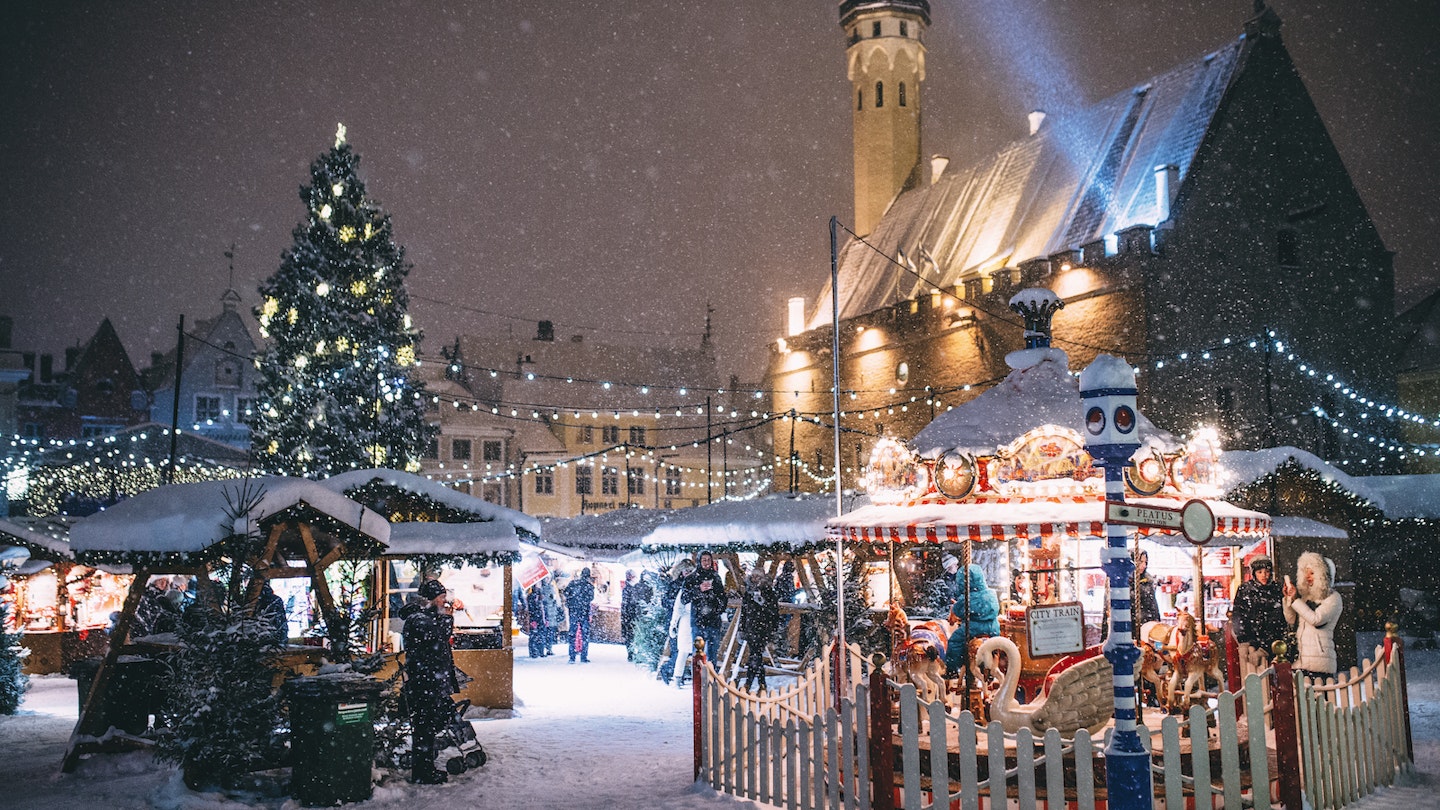When you’re situated as far north as Estonia’s fairytale capital, each season has its own distinct personality. Summer days seem to stretch forever, but so do winter nights. Within their turreted old-town walls, the locals have learned to cope with nature’s rhythms with season-specific traditions and tailored festivals to get them through even the coldest months.
Winter’s Festive Spirit
If you think the frigid gloom of Baltic winter is an unappealing time to visit Tallinn, you’ve clearly never seen the snow glistening on the old-town roofs or skated around the Harju Ice Rink under the shadow of 13th-century St Nicholas’ Church.

It was in 1441 that the unfortunately-named Brotherhood of the Black Heads (a guild for unmarried merchants) erected the world’s first publicly displayed Christmas tree on picturesque Town Hall Square. Each year in mid-November, a huge tree is installed and decorated at the center of the square, remaining there until nearly the end of January. A Christmas market is held at its base, full of stallholders selling local crafts, hõõgvein (mulled wine), and roasted sweet almonds. Another traditional Christmas treat, verivorst (a blood sausage wrapped in pig’s intestine), is more of an acquired taste.
In Estonia, winter is a time for warming soups, stews, roast meat, and sauerkraut – but if hearty stodge fails to take the chill off, locals indulge in their favorite naked communal pastime: sweating it out in the sauna. Many hotels have saunas for their guests, but the luxurious private facilities of Club 26, atop the Radisson Blu Hotel Olümpia, can be booked by anyone. The Kalev Spa Waterpark provides a more egalitarian option, or for the traditional Russian banya (bathhouse) experience – complete with a birch-branch bashing – head to Kalma Saun.
Spring in Full Bloom
It takes a while for Tallinn to shrug off its white mantle, but any remaining icicles are bebopped away during the Jazzkaar Festival in mid-April, showcasing jazz greats from around the world. Neighborhoods spring to life for community events such as Kalamaja Days, a mid-May block party with outdoor concerts and markets. Cafes start to arrange tables on the squares, and restaurants garland their streetside terraces with flower boxes – while still ensuring that there are blankets at hand for customers to dispel any lingering chills. Spring produce transforms menus with the likes of wild garlic, sorrel, goat’s cheese, new-season lamb, and rhubarb.
The best places to see spring blooms are the Tallinn Botanic Garden, by the banks of the Pirita River in Kloostrimetsa, and gorgeous Kadriorg Park. Kadriorg, meaning ‘Catherine’s Valley’, is the formal garden of a tsarist-era palace, built by Peter the Great for his wife Catherine in the 18th century.
Summertime Activities
Summer is by far the most popular time to visit Tallinn; the warmer weather spawns an influx of cruise-ship passengers crowding the streets of Old Town. They’re usually all gone by early evening, so make like a local and head to the beach at Pirita or Stroomi during the middle of the day. Alternatively, head out on a kayak tour with the likes of Reimann Retked to Aegna Island. Return in the evening for al fresco dining in the city squares, feasting on the summer harvest of fresh vegetables and berries.
Summer is also the prime festival season, kicking off with the medieval-themed Old Town Days in late May. The three Baltic capitals (Tallinn, Rīga, and Vilnius) take turns to host Baltic Pride; Tallinn’s turn next comes up in June 2020.
Estonia reserves its biggest annual celebration for magical Midsummer’s Eve on June 23. Although Midsummer has been given a Christian name (Jaanipäev, meaning St John’s Day), there’s more than a touch of the pagan to these communal gatherings around the bonfire, where you’ll still spot damsels with a garland of flowers or oak leaves in their hair. The sun barely sets at all, and it’s considered very bad luck to go to sleep until the hour or so of twilight passes. While most Estonians prefer to escape for the countryside on Midsummer, the best place in Tallinn to experience the festivities is the Estonian Open-Air Museum in the city’s west. This wonderful expanse of coastal forest has been populated with heritage buildings, bringing the countryside to the city. Throughout summer, costumed staff demonstrate traditional skills amongst the transplanted farm buildings, windmills, taverns, and churches.
July’s Medieval Days bring jousting demonstrations and a costumed carnival to the edge of the Old Town, while Maritime Days moves the action to the city’s marinas and the fascinating Seaplane Harbour. Things are rather more decorous during the Tallinn Organ Festival and August’s Birgitta Festival, a week-long series of classical music, dance, and theatre performances held within the enigmatic shell of a ruined convent.
Autumn’s Vibrant Colours
As the weather cools down, head to Kadriorg Park, the Tallinn Botanic Garden, or the Open-Air Museum to see the leaves changing. Other good places include Kalamaja Park, to the west of the Old Town, and Viimsi Open Air Museum, a preserved 19th-century farm and seaside village in the city’s northeast. It’s also a brilliant time to take a day trip to Lahemaa National Park – the ‘Land of Bays’ – a blissful stretch of coastal forest 45km east of the city, crisscrossed with hiking and biking tracks.
Autumn is hunting season, so expect game meats to begin appearing on menus. It’s also a prime time for foraging for mushrooms, a traditional activity which is something of a national obsession.
As nights lengthen, September’s Wandering Lights festival turns Kadriorg Park into a fairyland, with light installations illuminating the palace gardens. Performers also brighten spirits on the main stage set up on Town Hall Square. Towards the end of the season, locals take their minds off the impending winter with the Black Nights Film Festival, held in mid-November.
Produced by GoTravelDaily for Visit Tallinn. All editorial views are those of GoTravelDaily alone and reflect our policy of editorial independence and impartiality.





